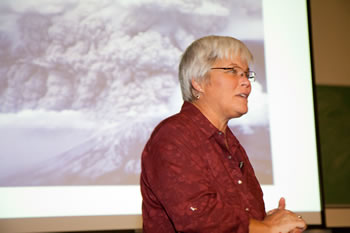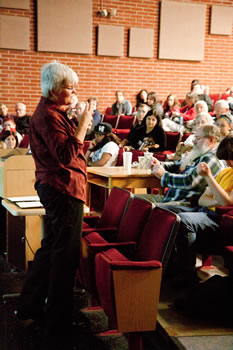At the college and in the community, Clark College is a leader.
 |
| At the college and in the community, Clark College is a leader. Earthshaking News
Vancouver, Washington (and, in fact, the whole Pacific Northwest) is located in a region of immense seismic activity with the potential for all kinds of natural disasters. Hence the name of Dr. Charlene Montierth’s lecture, “Volcanoes and Earthquakes and Tsunamis, Oh My: Living on a (Tectonic) Edge.” Watch Dr. Montierth's presentation. Held on Thursday, November 4 as part of the college Faculty Speaker Series, Montierth’s presentation gave a clear and level-headed summary of the hazards facing those living on the border between the Juan de Fuca and the North American tectonic plates. When tectonic plates like these interact, they can create such phenomena as volcanoes, earthquakes, or tsunamis, depending on how they move. “We live in one of the most amazing places imaginable for trying to understand these processes,” Montierth said. “Because what we have here in the Pacific Northwest is a little bit of everything.”
With the help of series of Powerpoint slides, Montierth outlined some possible scenarios arising from that subduction zone, including the eruption of Mount Rainier (“the scariest volcano in the Pacific Northwest”) or Mount St. Helens (“what we saw in 1980 was actually small in comparison to what St. Helens has proven to be capable of”). She also showed a chilling video provided by the Washington State Department of Transportation of a computer-animated simulation of what might happen to the Alaskan Way Viaduct in Seattle if a magnitude 7 earthquake hit 20 miles outside the city. Audience members gasped as the Seattle waterfront crumbled and the Viaduct collapsed. But Montierth’s presentation was hardly a gloomy littany of doomsday predictions. “Volcanoes like this are generally pretty good at signaling their intent,” she pointed out, noting that modern seismology has become increasingly adept at tracking and predicting volcanic activity. And she also advocated strongly for each member of the audience to have a plan in place for themselves and their loved ones in case of an emergency. “Planning before, during, and after an event is probably going to be key to your happiness if you experience an event like this,” she said. “The key to surviving these kinds of events … know how to turn off the gas, know what to do if the electricity goes out, know who you are going to call to check in.” Appropriately enough, members of the Emergency Management Planning Committee were on hand to pass out fliers with information about how to stay safe during an earthquake. More information about emergency preparedness is available at www.clark.edu/security. The Faculty Speaker Series, established by Clark College with support from the Clark College Foundation, honors individual faculty members and celebrates academic excellence. The next faculty member to speak in the series is Economics Professor James M. Craven. His lecture, “International Education within and from China: Emerging Opportunities, Challenges, and Constraints” is scheduled for Tuesday, February 8 at 4:00 p.m. in PUB 258. |


